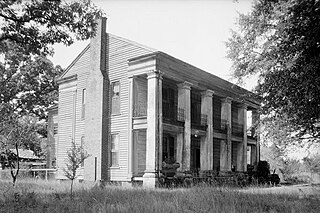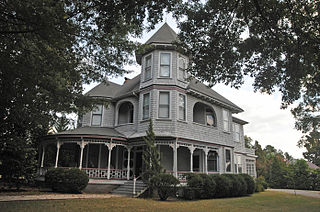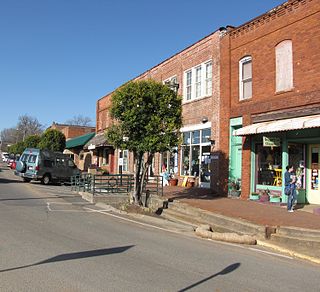
The Zachary-Tolbert House, also known as the Mordecai Zachary House, is a restored pre-American Civil War house located at Cashiers, Jackson County, North Carolina. The house was built between 1850 and 1852, and is a two-story, five bay Greek Revival style frame dwelling. It has a low hipped roof and central front, two-story, portico. A frame two-room kitchen was added to the rear elevation and was connected to the house by a covered breezeway in the 1920s.

Beaufort Historic District is a historic district in Beaufort, South Carolina. It was listed on the National Register of Historic Places in 1969, and was declared a National Historic Landmark in 1973.

Christ Episcopal Church and Parish House is a historic Episcopal church located at 320 Pollock Street in New Bern, Craven County, North Carolina. It was built in 1871, incorporating the brick shell of the previous church built in 1824. It is a brick church building in a restrained Gothic Revival style. It features a three-stage entrance tower, with a pyramidal roof and octagonal spire. Beneath the tower is a Stick Style entrance porch added in 1884. The parish house was built between 1904 and 1908, and is a two-story, three bay by five bay, rectangular red brick building with a steep slate gable roof.

The Henry House, also known as the Lowry-Ford-Henry House, is a historic antebellum plantation house in Marion, Perry County, Alabama. Historians believe that the house was built during the 1840s for Squire Lowry, a wealthy planter originally from North Carolina. The two-story, L-shaped house is wood framed with a brick masonry foundation and columns. A monumentally scaled hexastyle portico spans the three-bay front facade. Another two-story, L-shaped portico spans the exposed half of the rear facade and one side of the two-story rear wing. The Bert Ford family purchased the house from the Lowry family. It then passed to the Henry family, the Ford heirs. The last individual to own the house was Mary Katherine Blount, a native of Montgomery. She purchased the house and subsequently donated it to the Perry County Historical and Preservation Society. It was added to the National Register of Historic Places on September 25, 1986.

Jacob Henry House is a historic home located at Beaufort, Carteret County, North Carolina. It was built about 1794, and is a 2 1/2-story, four bay by four bay, Federal style frame dwelling. It rests on a high foundation of ballast stone and has a two-tier, full-width front porch. It was the home of Jacob Henry, who in 1809 entered into a debate over his right as a Jew to hold state office.

Snipes–Fox House is a historic home located at Siler City, Chatham County, North Carolina. It was built about 1900, and is a two-story, three bay Late Victorian style frame dwelling. It features an expansive wrap-around porch and unique interior woodwork. Also on the property is a contributing frame front-gabled smokehouse.

Twin Houses is a historic home located at Shawboro, Currituck County, North Carolina. It was built about 1797, and consists of two separate two-story, five bay by two bay, identical Federal style structures, joined by a transverse hall. Each house has a hall-and-parlor plan, exterior end chimneys, and they are connected by a one-story, gable roofed, connecting hall.

Adolphus W. Umstead House is a historic home located at Bahama, Durham County, North Carolina. It was built about 1850, and is a two-story, three bay, Greek Revival style frame I-house. It has a long one-story offset rear ell and a one-story one-room side wing. Also on the property is a contributing stable.

The Andrews-Duncan House is a historic building located at 407 North Blount Street in Raleigh, North Carolina, United States. Built in 1874 for a prominent businessman, the Italianate style home was designed by architect George S. H. Appleget. The house was added to the National Register of Historic Places (NRHP) in 1972 and is currently owned by the state government. A large tree named after a presidential candidate once stood behind the house and is commemorated with a historical marker.

Eli Hoyle House is a historic plantation house located near Dallas, Gaston County, North Carolina. It was built about 1830–1833, and is a two-story, five bay, Federal-style frame dwelling. It has a side-gable roof, exterior brick end chimneys, and sits on a stone foundation. It was built by Eli Hoyle (1801–1844), great-grandson of Pieter Hieyl who built the nearby Hoyle Historic Homestead.

William Rea Store is a historic commercial building located in the Murfreesboro Historic District at Murfreesboro, Hertford County, North Carolina. It was built about 1790, and is a two-story, three bay, brick building with a one-story, three bay wing. It is one of the oldest commercial buildings in North Carolina. It was built by William Rea, a wealthy Boston merchant.

Henry Eccles House is a historic home located at Statesville, Iredell County, North Carolina. The house was built about 1861, and is a two-story, three bay by two bay, frame Greek Revival style dwelling. It has a low hipped roof, one-story rear addition, and two interior brick chimneys. Also on the property is a contributing log barn.

Henry Turner House and Caldwell–Turner Mill Site is a historic home, grist mill site, and national historic district located at Statesville, Iredell County, North Carolina. The house was built about 1860, and is a two-story, three bay by two bay, frame dwelling with Greek Revival style design elements. It has a gable roof, exterior end chimneys, rear ell extension, two 12-foot-deep hand-dug cisterns, and a two-story, pedimented front entrance porch. Also on the property is the site of a grist mill, race, and dam and a family cemetery.

Henry Ottinger House, also known as The Willows, is a historic home located near Hot Springs, Madison County, North Carolina. It was built about 1855, and is a two-story, three-bay, vernacular Greek Revival style brick dwelling. It has double-pile plan with hipped roof and paired interior chimneys. The front facade features a two-story, single-bay entrance portico. Also on the property are the contributing major barn (1908), carriage house, and slaughter house.

Textile Mill Supply Company Building is a historic factory building located at Charlotte, Mecklenburg County, North Carolina. It was designed by Lockwood, Greene & Co. and built in 1922. It is a three-story, ten-bay wide by-five-bay deep, red brick structure with a full basement. It has large rectangular windows and pine post-and-beam interior framing. The building housed the Textile Mill Supply Company that sold and distributed supplies essential to the operations of textile mills in the Piedmont sections of the Carolinas.

J.C. Black House is a historic home located at Carthage, Moore County, North Carolina. It was built in 1893, and is a large two-story, rectangular Queen Anne style frame dwelling. It sits on a brick foundation and has a hipped roof. It features a three-story, polygonal corner tower, recessed balcony, round two-story bay, and a front porch with decorative sawnwork, turned brackets, and a spindle frieze. Also on the property is a contributing fanciful, polygonal well house.

Jonathan Hill Jacocks House is a historic plantation house located in New Hope Township, Perquimans County, North Carolina. It is a large, two-story, frame dwelling consisting of two houses joined in an L-plan configuration. The older section is a two-story, three bay, single pile Federal style frame structure. About 1838, it was enlarged to a central hall plan with six bays, and with a two-story rear ell. It was also renovated in the Greek Revival style. A full width portico with Doric order columns was added about 1847-1848.

Luther Henry Caldwell House is a historic home located at Lumberton, Robeson County, North Carolina. It was built between 1893 and 1903, and is a large two-story, eclectic Queen Anne style frame dwelling. It features a double tier wraparound porch with an octagonal pavilion and decorative woodwork on the porches, bayed gable end projections, and gable fronts. It was the home of Luther Henry Caldwell, an important business and social leader in Lumberton.

Solomon and Henry Weil Houses are two historic homes located at Goldsboro, Wayne County, North Carolina. They were built in 1875 for two brothers, and are nearly identical two-story, rectangular, Late Victorian frame dwellings. They feature projecting bays, bay windows, porches, and verandahs.

William Henry and Sarah Holderness House, also known as the Holderness-Paschal-Page House, is a historic plantation house located near Yanceyville, Caswell County, North Carolina. It was built about 1855, and is a two-story, Greek Revival style frame dwelling. It consists of a three-bay, hip roofed, main block flanked by one-story, one-bay side wings. The front facade features a pedimented one-bay Greek Revival-style porch, also found on the wing entrances. The interior features architectural woodwork by Thomas Day. Also on the property are the contributing smokehouse and carriage house.






















